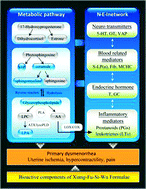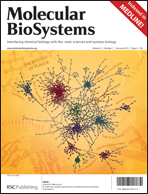Biomarkers of primary dysmenorrhea and herbal formula intervention: an exploratory metabonomics study of blood plasma and urine†
Abstract
Primary dysmenorrhea (PDM), a common clinical endocrine disorder affecting young women, is associated with endocrinopathy and metabolic abnormalities. Although some physiological and pathological function parameters have been investigated, little information about the changes of small metabolites in biofluids has been reported, which may cause poor diagnosis and treatment for PDM. The Xiang-Fu–Si-Wu Formula (XFSWF) is a Chinese herbal formula used to treat PDM for hundreds of years. The aim of this study was to establish the metabolic profile of PDM and investigate the action mechanism of XFSWF effect. In this cross-sectional study of 25 patients with PDM and 12 healthy controls, contents of small molecular endogenous metabolites in blood plasma and urine samples were measured by ultra performance liquid chromatography (UPLC) coupled with quadrupole-time-of-flight mass spectrometry (QTOF/MS) and triple quadrupole mass spectrometry (QqQ/MS) based techniques and analyzed by multivariate statistical methods. The levels of LPCs including lypso (16 : 1), lysoPC(20 : 4), lysoPC(18 : 2), lysoPC(16 : 0), lysoPC(18 : 1), lysoPC(10 : 1), estrone, 17-hydroxyprogesterone, myristoylglycine and palmitoylglycine increased significantly (p < 0.05) in PDM, while the levels of phytosphingosine, dihydrocortisol and sphingosine decreased significantly (p < 0.05) compared with the healthy controls. These significant perturbations are involved in glycerophospholipid metabolism and sphingolipid metabolism, as well as steroid hormone biosynthesis. The metabolic deviations recovered to the normal level after XFSWF intervention. The results demonstrated that biofluids metabonomics was a powerful tool in clinical diagnosis and treatment of PDM for providing information on changes in metabolites and neural, endocrinal and immune pathways. XFSWF can be used for the treatment of PDM cases, especially for those adolescents who do not desire a contraceptive method, to reduce the risk of secondary dysmenorrhea.


 Please wait while we load your content...
Please wait while we load your content...